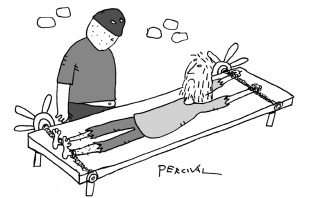I am assured that this is not a legend. But a few years ago, an Irishman’s life was twice saved by a raging bull. The Irish fellow was running with the bulls at a town near Pamplona. He tripped and was virtually impaled. The bull’s horn went into one side of the chap’s stomach and out of the other. He was rushed to a neighbouring hospital, which was accustomed to bull wounds, and the surgeons saved his life. While they were doing so, the aeroplane that he should have been catching took off. There were no survivors.
Fifteen years later, the Irishman developed gut rot. One doctor wondered whether scar tissue from the horn wound might be causing the problem. So the patient was opened up. Scar tissue was indeed present and was excised, as was pancreatic cancer at a very early stage. Generally regarded as especially lethal, it is usually impossible to detect until too late. The man lived. So a bull rescued a human being from two mortal perils. In the glorious history of bullfighting, that is surely a unique occurrence.
Columbus wanted a robust wine for his mariners and it did help them to cross the Atlantic
With my friends Alice Archer and Alexander Woolgar-Toms, we were considering bulls the other evening, over some excellent Numanthia, wine from the Bodega of the same name. Its grape varietal is Tinta de Toro – Toro as in bull – and it is an exemplar of the Spanish character. Vines have been grown there since Roman times. But although the Romans imported the grape, the inhabitants of Numancia were not loyal subjects. Indeed, they seem to have been real-life versions of Asterix and Obelix. They fought hard in resistance to Roman domination and finally burnt their town rather than surrendering it.
Their intransigence may have come from the terroir. It is a region of harsh winters and fierce summers. Earlier on, Tinto de Toro made a contribution to Spanish greatness. Columbus wanted a robust red wine for his mariners and it did help them to cross the Atlantic and begin the conquest of New Spain: the start of the Golden Age of Spanish history. So Tinta de Toro was present at the creation.

Ancient origins, old vines and long-matured vinicultural traditions: Numanthia has deep roots in the past, which is why the vineyard is named after Numancia, the prototype of Spanish patriotism – the townspeople who grew the Romans’ grapes but never accepted their government. But there is also modernity. Numanthia and its sister wine Termanthia are subtle and well-made. Blistering summer heat does not make life easy for the vignerons, and it is always difficult to keep the alcohol level at bay. As Ernest Hemingway said of Châteauneuf: ‘This is not a lunchtime wine.’ But it drinks exceptionally well over a good dinner.
The Bodega was only founded in the 1990s and is part of its own new Spain, in the form of a great increase in the number of young wine-makers. They all seem to have studied abroad, especially in France. But then they returned home, to fuse new methods and well-established traditions.
Spain is still a divided country, though it is hardly alone in that. But its history is forcefully contested. If history is past politics, in Spain the history often becomes present politics. Twenty-odd years ago, on a first political trip to Spain, I wrote that I had never known a country whose elite seemed to take its political identity from a supposed European future, rather than from the country’s past. In liberal circles, I suspect that this is still the case. But the new wine-makers’ successes may help to boost national self-confidence. If so, Numanthia is an excellent example.






Comments